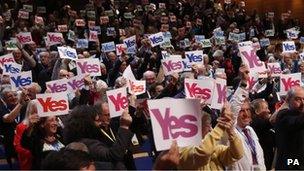Making a pitch for independence
- Published

Alex Salmond told the SNP conference that Holyrood was more trusted than Westminster
On display at this SNP conference, a selection of the strategies and narratives which will help form the Nationalist pitch in the referendum.
Two from Alex Salmond in his thoughtful conference speech. Firstly, he depicted independence as part of a continuum from devolution - a narrative he has already essayed through his use of the formula "Home Rule road."
Secondly, he sought to conflate the Conservatives and Labour, depicting them as a conjoined Hydra standing in the way of what he regards as the route to Scottish success.
On the continuum point, Mr Salmond sought to reassemble the collective pitch which secured devolution in the 1997 referendum - albeit with different players.
He argued that there was support for more powers at Holyrood, that the Scottish Parliament was more trusted than Westminster - and that, with endeavour, those two positions could be developed to generate a referendum majority.
On conflation, Mr Salmond was more specific. He depicted both Labour and the Tories as posing a challenge to the social welfare gains which, he said, had been driven by the Scottish Parliament.
The Tories because of their austerity budgeting
And Labour because of Johann Lamont's questioning of universalism in public benefit provision.

Yes campaign placards were held up at the conference on Saturday
Naturally, both those parties - and, indeed the Liberal Democrats - would reject the notion that they have subjugated their identities, either on policy or through sharing a position on the Union. They would point out that the SNP are in Yes Scotland alongside the Greens and the Socialists while differing from them on key points.
More generally, Mr Salmond's objective is to depict this as a contest between the forces of reform, led by himself, and the forces of reaction, led by the prime minister. He wants to posit the choice as being between social welfare provision under Holyrood and retrenchment from the parties supporting the Union.
Another strategy in evidence here is to provide reassurance to the voters that much would be untouched by independence, that change would be progressive and steady, not revolutionary and cataclysmic.
Hence the retention of the monarchy, hence the retention of sterling, hence the emphasis on continuing membership of the EU. Hence the remarkably close vote at this conference on continued membership of Nato, post independence.
'Chippy and hostile'
Perhaps I might draw one further strategy to your attention which was flagged up gently by Fiona Hyslop. She said that these islands faced a threat from Nationalism.
Hang on, she said what? Let me explain. The Nationalism she was decrying was "British nationalism" which, she said, was "narrow, chippy and hostile". In evidence, she cited disquiet south of the border about EU membership and a "national myth of military power" which, she said, was fostered by the Tory-led UK government.
In one sense, this is just another facet of Mr Salmond's argument that the referendum will be a fight between SNP and Tory.
But SNP strategists believe they can develop the concept outlined by Ms Hyslop. They believe that they can suggest that the UK's sense of itself, particularly with regard to the EU, represents uncertainty and dither by contrast with what Ms Hyslop described as "the grand progressive civic nationalism" of the SNP.